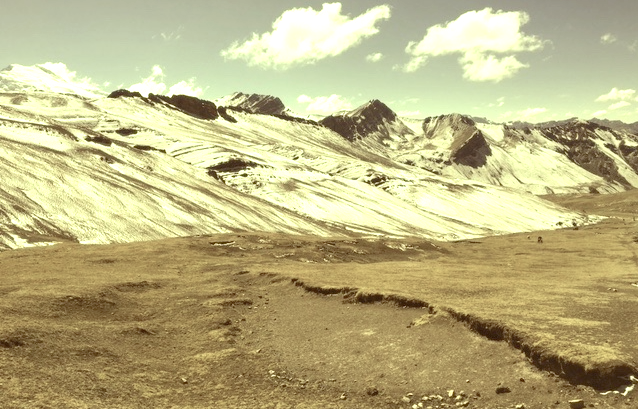3 photos of El Misti from Arequipa between 1917-1930
El Misti (5,822m -19,101ft) also known as Guagua Putina, is a stratovolcano located in southern Peru near the city of Arequipa. With its seasonally snow-capped, symmetrical cone, Misti lies between mount Chachani (6,075m - 19,931ft) and Pichu Pichu volcano (5,669 m -18,599 ft).
El Misti is located at 3,415m above the sea level on the Altiplano and the elevation of the cone is approximatively 2,400m above the Altiplano base. El Misti has three concentric craters. In the inner crater fumarole activity can often be seen. The symmetric conical shape of El Misti is typical of a stratovolcano, a type of volcano characterized by alternating layers of lava and debris from explosive eruptions, such as ash and pyroclastic flows. Stratovolcanoes are usually located on the continental crust above a subducting tectonic plate. The magma feeding the stratovolcanoes of the Andes Mountains, including El Misti, is associated with ongoing subduction of the Nazca Plate beneath the South American Plate. Its most recent relatively minor eruption was in 1985, 198 years after its previous documented eruption. Near the inner crater six Inca mummies and rare Inca artifacts were found in 1998 during a month-long excavation directed by archaeologists Johan Reinhard and Jose Antonio Chavez. These findings are currently stored at the Museo de Santuarios Andinos in Arequipa.
The city center of Arequipa, Peru, lies only 17 kilometers (11 miles) away from the summit of El Misti; the gray urban area is bordered by green agricultural fields. With almost 1 million residents in 2009, it is the second largest city in Peru in terms of population. Much of the building stone for Arequipa, known locally as sillar, is quarried from nearby pyroclastic flow deposits that are white. Arequipa is known as the “White City” because of the prevalence of this building material. The Chili River extends northeastwards from the city center and flows through a canyon between El Misti volcano and Nevado Chachani to the north. Nevado Chachani is a volcanic complex that may have erupted during the Holocene Epoch (from about 10,000 years ago to the present), but no historical eruptions have been observed there.
Climbing
There are two main climbing routes on the volcano. The Pastores route starts at 3,300 m-10,800 f). Usually a camp is made in 4,500 m -14,800 ft at Nido de Aguilas. The Aguada Blanca route starts at 4,000 m- 13,100 ft near the Aguada Blanca reservoir, and a camp is made in 4,800 m -15,700 ft at Monte Blanco (the camp is named after Mont Blanc, the summit of which is approximately the same elevation as the camp). Neither climbing routes presents technical difficulties, but both are considered strenuous because of the steep loose sand slopes.
The photographer
Martín Chambi Jiménez or Martín Chambi de Coaza, was a photographer, originally from southern Peru. He was one of the first major indigenous Latin American photographers. Recognized for the profound historic and ethnic documentary value of his photographs, he was a prolific portrait photographer in the towns and countryside of the Peruvian Andes. As well as being the leading portrait photographer in Cuzco, Chambi made many landscape photographs, which he sold mainly in the form of postcards, a format he pioneered in Peru.
In 1979, New York's MOMA held a Chambi retrospective, which later traveled to various locations and inspired other international expositions of his work.
Martín Chambi was born into a Quechua-speaking peasant family in one of the poorest regions of Peru, at the end of the nineteenth century. When his father went to work in a Carabaya Province gold mine on a small tributary of the River Inambari, Martin went along. There he had his first contact with photography, learning the rudiments from the photographer of the Santo Domingo Mine near Coaza (owned by the Inca Mining Company of Bradford, Pa). This chance encounter planted the spark that made him seek to support himself as a professional photographer. With that idea in mind, he headed in 1908 to the city of Arequipa, where photography was more developed and where there were established photographers who had taken the time to develop individual photographic styles and impeccable technique.
Chambi initially served as an apprentice in the studio of Max T. Vargas, but after nine years set up his own studio in Sicuani in 1917, publishing his first postcards in November of that year. In 1923 he moved to Cuzco and opened a studio there, photographing both society figures and his indigenous compatriots. During his career, Chambi also travelled the Andes extensively, photographing the landscapes, Inca ruins, and local people.
The archives of Martin Chambi's works are kept in Cuzco in his own house and by the care of his family. Everything is preserved in boxes, left by the photographer, classified and numbered by his own hand. A recent inventory has enumerated about 30,000 photographic plates and more than 12,000 to 15,000 photograph (rolls). Scanning work is in progress to retrieve photographic plates and photos.
"It is wrong to focus too much on the testimonial value of his photos. They have that, indeed, but, in equal measure they express the milieu in which he lived and they show (...) that when he got behind a camera, he became a giant, a true inventor, a veritable force of invention, a recreator of life."
(Mario Vargas Llosa)
Sources:
- Martin Chambi official Website






















